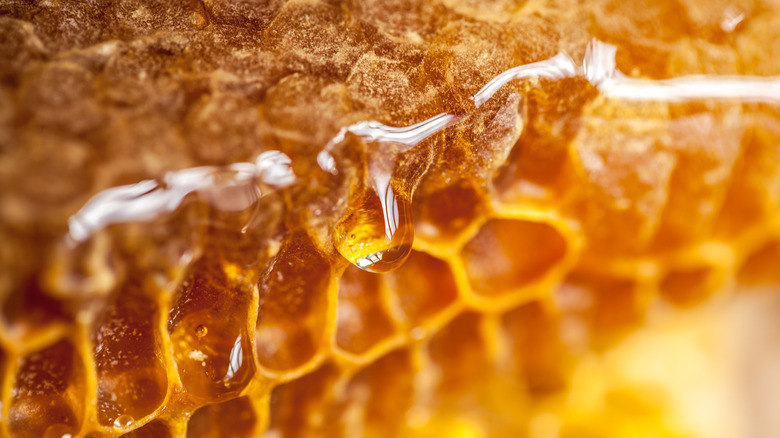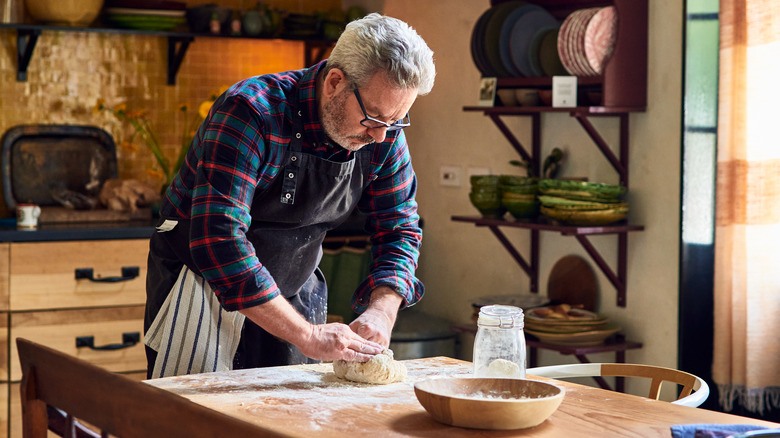Sourdough is a remarkably simple bread to make, which explains its popularity during the pandemic. All you need for a delicious loaf is three common ingredients — flour, water, and salt — and a lot of patience. It’s such an easy recipe, you may wonder if there’s any room for you to experiment by introducing other ingredients to your dough. While the natural processes that turn yeast into bread can be upset by all-too-common mistakes that can kill your sourdough starter, sugar can have positive effects on your sourdough’s flavor and texture, and honey is a great substitute for it. Honey can temper that signature sour flavor and soften the crumb, making your bread lighter and better suited for sandwiches and rolls, while also lending the crust a nice golden hue.
However, adding any sugar to your dough carries the risk of disrupting the delicate balance of microbial activity buzzing away within it. Sugar can make your dough rise faster, but as there’s enough sugar in flour to feed your yeast, it doesn’t need more of the sweet stuff to grow. Pure sugar also doesn’t have the protein flour does, so while the yeast in your starter will gobble up any extra sugar you add, it’s not going to make it grow any faster. It can even slow it down by drying out the yeast cells.
Honey can have the same effect — in fact, it’s even sweeter than sugar. So it’s important to remember that a little goes a long way.
The science of sourdough and honey
Sourdough’s distinctive flavor is a result of the fermentation process triggered by feeding flour and water to the natural yeasts living all around us. The bread’s sharp, sour taste comes from all the lactic and acetic acids that build up in the dough while the yeast and bacteria are working their magic, and the sweetness of honey can mellow out that acidity.
While that’s not the only way you can tweak the tang of sourdough, honey has the advantage of triggering other pleasant side effects. Its liquid composition increases the hydration of the dough, which will make the dough harder to work with, but also help the finished bread be less chewy. Adding honey is also one way to achieve that lovely brown crust on your sourdough, as sugar can help set off the Maillard reaction in the oven that makes a dark crust so tasty.
In addition to all the steps you can take for the best way to store your homemade sourdough, baking with honey can also help your bread stay fresh longer. Bread goes stale when it loses moisture, but honey actually draws in and retains water. And despite its sweetness, honey is acidic enough to ward off mold.
Adding honey like a pro
The key to baking sourdough with honey is knowing which honey to use, how much to mix in, and when to add it. Raw honey is recommended over the clear-looking pasteurized variety, as the yeast from the honeycomb is left alive. For vegans and children too young to eat honey, you can also sub in maple syrup, date syrup, or agave nectar (or regular old sugar).
Again, you only need a little. Generally speaking, every four cups of flour calls for a third of a cup of honey, so if you add too much honey, you’ll have to start balancing it out with more flour.
Most recipes ask you to incorporate the honey at the very beginning, when you’re mixing your starter with water, flour, and salt, but some call for the honey to be added while you stretch and fold the dough. The difference here is a matter of time: adding honey first will get the liquid in there during the autolyse process, when the flour and water turns into a pliable dough. Whatever you do, don’t bother adding honey to your sourdough starter. It won’t necessarily have any negative effects, but it won’t help things, either.







